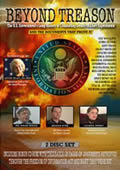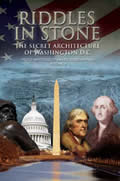PART 3 of 4
By
Marilyn MacGruder Barnewall
August 12, 2012
NewsWithViews.com
[Note: This is article 3 of a four part series. You can read part 1 here, part 2 here. The original article explaining the differences between Actives and Passives is here.]
Though the 1760 – 1810 cycle was definitely Active driven (Passives start wars, but prefer them to be on foreign soil and that those other than themselves fight in them), the attraction of power to political office already made itself felt through the influence of Alexander Hamilton. Hamilton was the one who recommended the first central bank (The Bank of the United States). He said the money needed to start the bank would come from the sale of $10 million in stock. The United States government would purchase the first $2 million in shares and the other $8 million would be available to the public as an investment in their new nation – and those abroad (like the Rothschilds) – could invest too.
Hamilton was aware that the U.S. didn't have $2 million and proposed the government borrow the money (how Passive/liberal is that?) it needed from the central bank. The loan would be repaid in ten equal annual installments. One-quarter of the purchase price had to be paid in gold or silver. The rest could be paid in bonds or acceptable scrip.
Few people today would argue that support for a central bank is a Passive/liberal concept designed to minimize the need for Congressional risk management by passing it on to a central bank. Today, we call it the Federal Reserve System… unlawfully legislated by Congress in 1913. Unlawfully? The U.S. Constitution says in Article I Section 8 that "The Congress shall have Power To lay and collect Taxes, Duties, Imposts and Excises, to pay the Debts and provide for the common Defence and general Welfare of the United States…" It takes an Amendment to the Constitution to change Article I Section 8; and that requires a vote of the American people. This did not happen when the Federal Reserve came into being… Congress merely passed legislation. Congress, then, passed legislation called the Federal Reserve Act of 1913. It was unlawful and it violated the Constitution of the United States each member of Congress had taken an Oath to uphold. Too, there was much skullduggery involved in how the FRA of 1913 was passed.
This is a mystery in the midst of an Active cycle. Actives were the dominant power from 1760 – 1810, yet Passives exercised great power in the establishment of the financial system that would run the new nation's economy by implementing the nation's first central bank in 1791. Actually, this is the first giant clue about the appeal of the power found in government – particularly in finance – to the liberal faction of our population. Few Americans would argue with the idea that a large percentage of Republicans who call themselves conservative (or, Active) can spell the word, let alone define it or legislate like a conservative. Actives are motivated by control of self destiny; Passives are motivated to gain power over others (and that is why so many Passives who call themselves Democrat or Republican) are attracted to that ballpark.
In the midst of Hamilton's drive for a central bank – and we must sympathize with the fact that this was the first Congress and they were struggling to find their way – Secretary of State Thomas Jefferson and Representative James Madison believed the centralization of power away from local banks was dangerous to a sound monetary system and would mostly benefit business, not the people (and they were correct). They also opposed the central bank on the basis that it violated the Constitution which gave responsibility for monetary policy to Congress. Jefferson argued that the bank violated traditional property laws. Madison did not believe Congress had the power to incorporate a bank (or any other government agency). George Washington was hesitant to sign the bank into existence. His attorney general, Edmund Randolph of Virginia, said such a bank was unconstitutional, but Washington signed the bill on April 25, 1791 giving America its first central bank. The bank only had a 20 year charter and it expired in 1811 without being renewed. In the end analysis, entrepreneurial Actives of the 1760-1810 cycle did exercise their majority by preventing a renewal of the bank's charter – and a great effort to renew it (including bribery) was implemented.
In 1810, the Passive cycle made us expansionary (expansion is related to Passive power – Actives innovate and Passives expand the innovation). The United States declared war on Great Britain in 1812. It began with a failed American invasion of Canada (we surrendered Detroit – perhaps we could do so again?), and ended when we won the battle of New Orleans, fought after the Treaty of Ghent was signed. The Passive cycle would last until 1860 and liberals would dominate until that time.
A funny thing happened on the Passive way to their powerful political forum… those pesky Active inventors began leading us into the early phases of the industrial revolution. The threat of war sounded. The lifestyle of the South – the sense of power enjoyed by those who exercised it – was strong. It motivated a "fight to preserve our way of life and keep things as they are" response.
People motivated by power – Passives – will fight to preserve it. The War Between the States (Civil War), unlike the Revolutionary War nearly a hundred years before, was motivated in the south by the need to maintain power over others. Their economy, as they knew it, was dependent on it. Northerners fought to free a race of people from their bonds. At least, that's what we were taught. In reality, Eli Whitney's cotton gin made it possible for northern industry to process more cotton more quickly and less expensively than slave labor could. The innovation of Actives was just the beginning of what was to come; a long line of Whitneys and Fords and Edisons would follow. For those readers who will point it out to me, I am aware that the inventions of Nicola Tesla were kept hidden from the public eye and realize that many questions exist as to whether Thomas Edison or Nicola Tesla invented many items that were patented by Mr. Edison. That's another story. At the time the Active cycle began in 1860, the nation stood divided on the issue of slavery. Because of the cotton gin, America could become more competitive in world markets. This economic consideration was part of what motivated the Civil War. So, too, was the drive to keep the Union in tact.
The War Between the States began at Fort Sumter. It was very similar in purpose to the Revolutionary War if one views the freeing of humans to seek and control their own destinies the sole objective of the war. But it was not the sole objective. Nor was the war fought by slaves seeking their rights to self-determination. It was fought for them by those who value personal freedom… and money to fight the war was made available by greedy bankers who saw the industrial revolution coming and who profited from it in many ways.
Thus far in our history, we have fought two wars… both during 50-year cycles when Actives were in control. Are conservatives the purveyors of war?
We need to remember our history. Prior to William Jefferson Clinton, only four Democrat presidents in the 1900s served two terms in office: Woodrow Wilson, Franklin Roosevelt, Harry Truman, and Lyndon Johnson (though President Johnson served only one elected term).
These Passive liberal presidents initiated American involvement in the five major wars of this century: the War of 1812 (fought on American soil), World Wars I and II, and the Korean and Vietnam conflicts. In WWII alone, the total military dead (all nations) was from 22 to 25 million plus deaths in captivity of about 5 million prisoners of war.
Through 1992, there were five multi-term Republican presidents. The total number of years Republicans held the presidency during that 92-year period is 56 years. Or, the presidency was held by Republicans 61 percent of the time until the Clinton administration. No Active conservative president ever started a major war on foreign shores. George H.W. Bush, hardly a conservative and a one-term president, initiated action against Iraq in 1991 when Iraq aggressed against Kuwait (probably manipulated into doing so), but Americans killed in action in the Gulf War totaled only 148. There were 458 wounded, 121 non-hostile deaths, and 11 female combatant deaths.
The evidence is clear that Democrat presidents are far more likely to start major wars on foreign soil than are Republicans. The evidence is equally clear that Passive liberals are motivated by power, Active conservatives by control.
Isn't power versus control the reason behind every war fought since David slew Goliath? Actives learned that little David could slay big Goliath with a very controlled weapon like a sling- shot. During the Revolutionary War Active cycle, Patrick Henry's cry was a slingshot. At the time Abraham Lincoln first pointed to the moral wrong of slavery, his words were a slingshot.
At the end of the Civil War, we began moving from a series of regional agricultural economies to a unified national economy. The new economy was based on industry and manufacturing. Traditional wealth lost its power base. The same thing is happening today, with some critical differences.
As has always been the case during changes of America's economic base, the drive from the previous economy maintained its strong presence. The majority of people were now employed by industry and manufacturing but that did not reduce the importance of agriculture. Nor was agriculture viewed as inferior to industry and manufacturing. People understood the need to eat was primary to maintaining life. Agriculture was merely in the back seat, riding along in a new Model-T Ford that so exemplified the new industrial economy.
The only era in American history during which we have not maintained the vigor and strength of the preceding economy is the 1990's. Rather, we have allowed our industrial and manufacturing base to be shipped to third world nations in return for cheap labor making inexpensive products. It is one of those historic events that has resulted in a huge lesson… and it was the beginning of multi-national companies that dominate the world and have no allegiance to any nation, including America. Was it a planned event? I have always thought so.
In 1910, the new industrial and manufacturing economy that had been so resisted in the 1860's was in full swing. The economy became expansionary, typical of a security-driven Passive cycle. New fortunes were amassed and new wealth from the new industrial economy was now old enough to be considered respectable. The Robber Baron era ruled the day during this Passive cycle. Though energetically opposed by Actives, a central bank called the Federal Reserve (owned by banks, not the government) was established. This fifty-year wave cycle clearly belongs to the Passive security-motivated group.
Two world wars were fought during the Passive cycle of 1910 to 1960. Both reflected increasing American world power and honoring treaties -- Passive purposes.
| Subscribe to the NewsWithViews Daily News Alerts! |
The Revolutionary and Civil Wars were fought on American soil under the political oversight of Active conservatives. Both were fought to put a halt to power abuses exercised by one group of people over another and both were fought on home turf.
The new Active wave cycle began to emerge in 1960. The preceding fifty-year Passive cycle motivated the expansion of America's industrial and manufacturing complex. The Great Depression began under Passive dominance during this same time frame.
Click here for part -----> 1, 2, 3, 4,
� 2012 Marilyn M. Barnewall - All Rights Reserved
Sign Up For Free E-Mail Alerts
Marilyn MacGruder Barnewall began her career in 1956 as a journalist with the Wyoming Eagle in Cheyenne. During her 20 years (plus) as a banker and bank consultant, she wrote extensively for The American Banker, Bank Marketing Magazine, Trust Marketing Magazine, was U.S. Consulting Editor for Private Banker International (London/Dublin), and other major banking industry publications. She has written seven non-fiction books about banking and taught private banking at Colorado University for the American Bankers Association. She has authored seven banking books, one dog book, and two works of fiction (about banking, of course). She has served on numerous Boards in her community.
Barnewall is the former editor of The National Peace Officer Magazine and as a journalist has written guest editorials for the Denver Post, Rocky Mountain News and Newsweek, among others. On the Internet, she has written for News With Views, World Net Daily, Canada Free Press, Christian Business Daily, Business Reform, and others. She has been quoted in Time, Forbes, Wall Street Journal and other national and international publications. She can be found in Who's Who in America, Who's Who of American Women, Who's Who in Finance and Business, and Who's Who in the World.
Web site: http://marilynwrites.blogspot.com
E-Mail: marilynmacg@juno.com











 Share
This Article
Share
This Article



